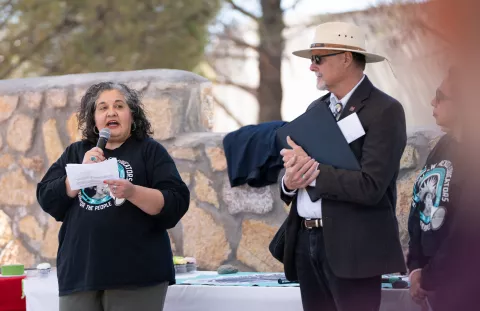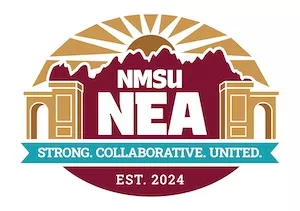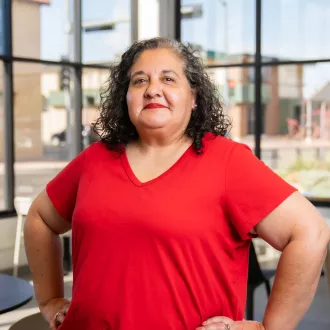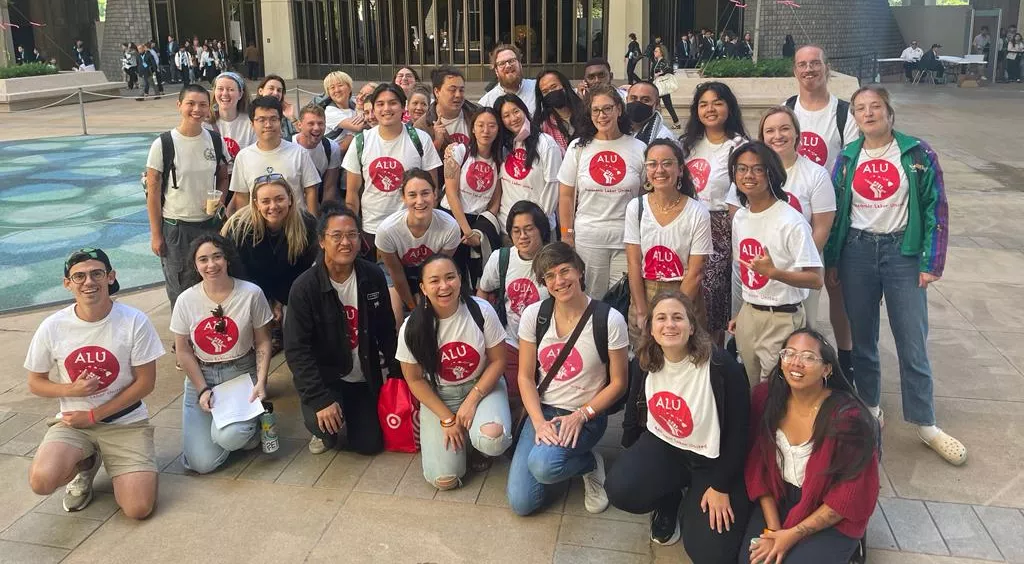Key Takeaways
- Between 2012 and 2024, the number of unionized faculty grew by 7.5 percent.
- During that same time, the number of grad-student employees in unions grew even faster, by 133 percent.
- A key issue for faculty, including the new union members at New Mexico State University, is having a voice that can’t be ignored. For grad-student employees, it’s largely about their awful pay.
Over the past decades, faculty at New Mexico State University (NMSU) talked sporadically about unionizing. A few years ago, they got serious. NMSU’s revolving door of university presidents, chancellors, provosts, and other highly paid administrators has been dizzying.
Amidst all the chaos at the top, faculty want—and need—a real voice in how the university works, says Amy García, an English professor and leader of the new NMSU faculty union. “Faculty have a wealth of experience and knowledge, and those voices need to be taken into account,” she says. “We want a seat at the table.”
Today, they’re getting it. In late July, the new NMSU-NEA union was recognized by the state labor board as the official bargaining representative for hundreds of faculty across the NMSU system.

With that, NMSU faculty joined a surging segment in the labor movement: higher-education employees. Between 2012 and January 2024, the number of unionized faculty grew by 7.5 percent, according to Hunter College’s newly released “2024 Directory of Bargaining Agents and Contracts in Institutions of Higher Education.” During that same period, the number of graduate-student employees in unions grew even faster, by a stunning 133 percent.
“Before we unionized, 63 percent of New Mexico faculty were unionized,” notes NMSU’s Patricia MacGregor-Mendoza. “Now, with us, it’s up to 85 percent. We’re really happy and proud to be part of the upward trend of unionization!”
Trends in Higher Ed Unionization
The “Hunter directory” has been published periodically since the 1970s by the National Center for the Study of Collective Bargaining in Higher Education and the Professions, a research center at Hunter College, City University of New York led by William A. Herbert. The latest publication, released earlier this month, includes data and analysis on 902 higher education unions and contracts, including 775 faculty unions and 81 made up of graduate student employees who typically work for their universities as teaching or research assistants.
Among its key findings:
- The total number of unionized faculty has grown by 7.5 percent since 2012, even as unionization among U.S. workers declined overall. The overwhelming majority (83.4%) of the new faculty unions contain non-tenure-track faculty, or those who work as contingent or adjunct faculty.
- Today, about 27 percent of faculty belong to unions, for a total of 402,217 unionized faculty. By comparison, just 11.3 percent of U.S. workers, in general, belong to unions—although tens of millions say they want to!
- Grad-student employee unionization is soaring. In January 2024, about 38 percent of GSEs belonged to unions, or more than 150,000. This is an increase of 133 percent since 2012.
- In 2012, there weren’t any undergraduate-student employee unions. Today, there are 3,515 undergrad-student union members in 19 unions across nine states. These include dining-hall workers, resident advisers, and college athletes, like Dartmouth College’s basketball players.
The directory also includes links to hundreds of faculty and other contracts. (NEA Higher Ed members also may find contracts through NEA’s own database of higher-ed contracts.) Access to these contracts means union leaders can see and demand the best contract language at their own bargaining tables.
“Change agents now have access to…813 contracts that shed light on ways to improve the working conditions in higher education,” notes Adrianna Kezar, University of Southern California professor and director of the Delphi Project on the Changing Faculty and Student Success.
Welcome to NEA, NMSU Faculty!
When it comes to working conditions at NMSU, faculty identify several issues. For one, pay is about 20 to 30 percent lower at NMSU than its peer institutions. “That’s one of the things that hinders us in being able to attract and keep new faculty members,” says MacGregor-Mendoza, a professor of Spanish and linguistics. “They say, ‘okay, New Mexico State is lovely. You’ve got great mountains. You’ve got great weather,’ but we can get paid $20,000 more at another institution with a lower teaching load.”

Another issue is workload: faculty are exhausted, says Garcia. “There’s this feeling of being tapped out, of being stretched beyond capacity,” she says. “One of our endeavors, as part of this unionization, is to focus on reasonable workload so that we can achieve quality teaching.”
During MacGregor-Mendoza’s nearly 30 years at NMSU, at least a dozen university presidents have come and gone. Only three lasted more than three years. At least four were interim office holders. The university hasn’t had a “permanent” president since 2022. It hopes to hire one this year.
Meanwhile, MacGregor-Mendoza, García and other NEA-NMSU leaders stay for decades. “You really feel like you’re making a difference in the lives of students and in the community,” says MacGregor-Mendoza. “That’s something really motivating for those of us who have been here a long time.”

All five NMSU campuses are federally classified Hispanic-Serving Institutions, with about two-thirds of students identifying as Hispanic and one in three as first-generation college students.
Faculty know these students. “We have decades of collective knowledge and energy,” says García. And yet, despite faculty’s talent and long relationships to NMSU’s communities, their voice has been overlooked by the whirling line of administrators. The existing NMSU faculty senate is an advisory body only.
“There’s the perception of shared governance,” says García. “But do they take that advice? The outcome is always different than the advice given. I think faculty would like the opportunity to participate in design and detail.”
Looking ahead, NEA-NMSU members now have the legal right to sit down at the bargaining table and negotiate a legally binding contract for faculty. Their top priority is better working and learning conditions. Says García, “This union effort is about developing our ideas to influence change in positive ways.”
The Surge in Grad-Student Employee Unions
While faculty unions like NEA-NMSU’s stake their ground, the propulsive engine of higher-ed unionization today is graduate-student unions. As the new Hunter study notes, the number of grad-student employees (GSEs) who belong to unions has “increased by a dramatic 133% in a little more than a decade.”
Nationwide, about four in 10 GSEs belong to a union.
Their big issue? Pay. On average, GSEs earned $19,000 in 2022-2023, according to NEA research. Making matters worse, many don’t get university-provided healthcare insurance, and much of their pay is eaten up by the student fees they still have to pay to their employers. “You might get a 2 percent raise, but then fees go up by 7 percent. For me, the fees are $191 out of every paycheck, almost $400 a month,” said Virginia Tech’s Aileen Suarez to NEA Today earlier this year.
At Virginia Tech, grad-student employees first launched a living-wage campaign in 2020. In 2023, they began organizing the NEA-affiliated Graduate Labor Union, joining an exploding number of union members.
“Between 2021 and 2023, there were 63,680 newly organized GSEs, which was nearly triple the number of newly organized GSEs during the prior eight years combined (20,394),” the study notes.
Most of the recent growth in GSE unions has occurred at private institutions, but it does include new NEA affiliates at public institutions like Tech and the University of Hawaii. Overall, about two-thirds of GSE union members work at public universities.
Interestingly, undergraduate students are another area of union growth, identified in the new study. Before 2022, just two U.S. colleges had unions of undergrad students. By the beginning of 2024, more than 3,500 undergrad students belonged to 19 undergrad unions across nine states. Frequently, these student-workers work in dining halls, campus offices, laboratories and libraries as resident advisers, custodians, lab technicians, and other non-classroom roles.
For example, the Cal State union represents 16,000 undergrad-student workers who are seeking higher pay, lower parking fees, and paid sick leave.
While the door is open for college athletes to organize, only the Dartmouth College basketball team has done so. (In 2014, the Northwestern University football team tried, but failed to unionize.)
Quote byAmy García , NEA-NMSU

Additional Findings
Other findings in the new Hunter directory include:
- The states with the highest percentage of unionized faculty are Hawaii (76.3%); Maine (73.6%); New Jersey (73.5%); Alaska (70.1%) and New York (70%).
- The lowest percentages? Maryland at 8.5 percent and North Carolina at less than 1 percent. (Maryland, however, has a new law that enables community college employees to collectively bargain, which may lead to notable increases in the future.)
- Most local faculty unions are affiliated with NEA (238 local affiliates), followed by the American Federation of Teachers (192.) Most graduate-student unions are affiliated with the United Auto Workers.



